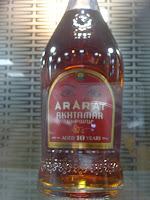Generally, I convey the story of my travels chronologically. But by the end of my stay in Yerevan, I recognized some reverberations had slowly woven together over the days. So it seems best to unravel the fabric of my visit by following not time, but these threads if you will.
My very last stop before my flight home was the Sergei Parajanov Museum, conveniently located a couple of blocks from my hotel. The tourist attraction, recommended to me by a friend, is oft listed as one of the most popular in the city, but on this day I was the only visitor to the former home of the film maker (left). The staff literally had to turn on the lights for me to see the displays, which contain artifacts from his movies but also his own artistic creations, including numerous collages made from everyday objects, such as dolls and magazines (right).
I went directly to the museum from my previous stop, the Ararat brandy factory, where I got a preview of Parajanov. A visual reference to perhaps his most well-known film, The Color of Pomegranates, is featured on a collector's edition label (top left). The factory displays a number of highly historic, and valuable, bottles, but its true purpose is as a climate-controlled aging facility (top right). Some of the precious nectar is contained in a "peace barrel," sitting in a special cupola, the only place where Azerbaijani and Armenian flags fly side by side, and waiting to be tapped when the two countries' conflict is resolved (middle). The factory tour included a tasting of two or three vintages (bottom left). I chose the trio with the reserve option, but it did not include any sips of the collector's editions, including one with a label by painter Martiros Sarian (bottom right).
One of my first stops in the city was the Sarian House-Museum, where I was immediately struck by the vivid colors he obtained with various media: oil, tempura, and watercolor. Many of his paintings are of real places, including Mount Ararat (top left), but I was drawn to his more fanciful "fairy tale" depictions, especially one simply called "Love" (top right). The gallery has been created within the family home, where you can walk into his skylit studio (bottom left) and peruse keepsakes, such as a letter of appreciation from John Updike, whose portrait he painted (bottom right).
Artistic blood ran through the family tree's veins. The painter's son, Ghazaros Sarian, composed works that have been performed by the national orchestra. However, he wasn't quite as heralded as Arno Babajanyan, whose expressive piano-playing style is illustrated in a sculpture by Swan Lake (top). Indeed, respect for art of all kinds is a never-ending well in Armenia. One of the main wares being sold at Vernissage market was the national instrument duduk, a cross between an oboe and a recorder (bottom left). In another park, French Square, a painting market pops up around a statue of -- you guessed it -- Martiros Sarian (bottom right).
Holding court before the architectural centerpiece of the city, the Cascade, is a monument to Alexander Tamanyan, the city's chief architect who built the Opera House (top left). He did not help construct the incline, which contains an arts center. Many people use the center's escalators to climb the hill, but it was closed for the holiday, so I braved the steps to survey Tamanyan's achievement (top right). Footsteps down and away is the Matenadaran, like the Library of Congress but much older. The archive, which was nominated as a UNESCO Memory of the World entry, is named after and features a monument to Mesrop Mashtots, inventor of the Armenian alphabet (bottom left). From atop the hillside, Mother Armenia keeps close watch on the country's gospels, manuscripts, and other ancient documents (bottom right).
The statue that previously loomed over the city was of Stalin. In 1962, that statue was toppled, and about thirty years later, Lenin's statue came tumbling after. It its place in Republic Square was a towering tree still in place for Apostolic Christmas (top left) and a variety of Saint Nicks extolling good cheer from in front of the National Gallery (top right). Many travel guidebooks say tourists come to Yerevan to see the Soviet architecture, but there was hardly a Soviet vibe amid the ongoing holiday celebrations. A main pedestrian shopping street had been converted to a Christmas market (bottom left), where parents snapped photos of their children in front of the nativity (bottom right).
The scene is casually carefree, a stark contrast to the country's relatively recent past. During the Armenian Genocide, many of the nationalistic Ottoman government's targets were Apostolic Christians. That atrocity was far from the first or only time Turkic groups invaded the territory; Yerevan was under the thumb of various Islamic rulers from the 11th through 14th centuries, as evidenced by the Blue Mosque (left), which was originally constructed in the 12th century and was rebuilt in the 18th (right).
Historically, the Kond district was home to the city's Muslim population (top left). Many Kond residents who helped survivors of the 1915 genocide became victims of the Soviet purges. Today, the religiously- and ethnically-mixed community considers itself somewhat outcast from the city (top right), a sad situation that is emphasized geographically: The neighborhood lies just over the valley from the Armenian Genocide Museum (bottom).


























